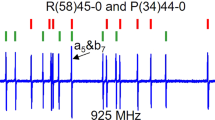Abstract
The method of Lamb dip spectroscopy in Stark tuned molecular gases is discussed and applied to the experimental assignment of methyl alcohol infrared transitions in the υ5 C−O stretch band. Theoretical expressions for Stark Lamb dip patterns are derived for P, Q and R-branch transitions. Stark tuning results and transition quantum number assignments are presented for several 10μm transitions, along with measured values of resonant frequencies, absorption coefficients and pressure broadening coefficients.
Similar content being viewed by others
References
M. Rosenbluh, R.J. Tempkin, and K.J. Button, Applied Optics15, 2635 (1976). See also Gibson, Ref. 5.
D. Woods, “The High Resolution Infrared Spectra of Normal and Deuterated Methanol between 400cm−1 and 1300cm−1,” Ph.D. Thesis, Univ. of Michigan, 1970 (unpublished).
Y.Y. Kwan and D.M. Dennison, J. Mol. Spectrosc. 43, 291 (1972).
R.B. Gibson, M.S. Feld and A. Javan, to be published in the Journal of Infrared and Millimeter Waves.
R.B. Gibson, “Far Infrared Spectroscopy of Methyl Alcohol Using Continously Tunable Tea Laser Optical Pumping,” Ph.D. Thesis, M.I.T., 1979 (unpublished).
J.O. Henningson, IEEE J. Quan. Elec.,QE-13, 435 (1977).
E.J. Danielewicz and P.D. Coleman, IEEE J. Quan. Elec.,QE-13, 485 (1977).
P. Toschek, in the Proceedings of the Aussois Conference on High-Resolution Molecular Spectroscopy, Colloques Internationaux du C.N.R.S. No217, Aussois, France, May 1973. See also other articles contained therein.
B.J. Orr and T. Oka, Appl. Phys. Lett.30, 468 (1977).
D.J. Bedwell, G. Duxbury, H. Herman, and C.A. Orengo, Infrared Phys.18, 453 (1978).
M. Inquscio, P. Minguzzi, A. Moretti, F. Strumia, and M. Tonelli, Appl. Phys.18, 261 (1979).
J.O. Henningsen, J. Mol. Spectrosc., to be
J.P. Sattler, T.L. Worchesky, and W.A. Riessler, Infrared Phys.18, 521 (1978).
Note that\(\begin{gathered} \smallint _{ - \infty }^\infty [1 + (\mathcal{Z} - a)^2 ]^{ - 1} [1 + (\mathcal{Z} - b)^2 ]^{ - 1} \alpha _\mathcal{Z} \hfill \\ = 2\pi [(a - b)^2 + 4]^{ - 1} . \hfill \\ \end{gathered} \)
C.H. Townes and A.L. Schawlow,Microwave Spectroscopy, Dover Publications, New York (1975).
Note that for P and R transitions with low J-values the multiplets may partially overlap, since δ is not much smaller than Δ [Eqs. (23)–(25)], making the pattern difficult to interpret.
A calibration of the PZT mirror movement alone did not provide an accurate frequency scale. The actual laser frequency was somewhat offset from the cavity mode peak due to the ∼25% frequency pulling which was present in the low Q, grating coupled laser cavity.
R.L. Shoemaker, S. Stenholm and Richard C. Brewer, Phys. Rev. A10, 2037 (1979).
This expression can be derived from the formula for the absorption [Ed. (12)] by taking the difference between\(\alpha |_{(E_0 + e)} \) and\(\alpha |_{(E_0 - e)} \) and simplifying for Jδ≪γ.
The possibility of absorption by P-branch transitions was excluded because these lines fell in the region of the υ5 CH3OH absorption where the R-branch lies (Ref. 2).
The center part of the signal in Fig. 9(b) results from a small leak of E ‖ EStark.
The small asymmetry splitting in CH3OH occurs only for A-type states, and is significant only for small K, as discussed in Ref. 3. For asymmetry parameter κ see Ref. 15.
D.G. Burkhard and D.M. Dennison, Phys. Rev.84, 408 (1951).
Two CH3OH absorption resonances were observed within the Doppler widths of two CO2 pump lines, the 9P(36) and 9R(16). See Table I.
J.O. Henningsen, IEEE J. Quan. Elec.,QE-14, 958 (1978).
Author information
Authors and Affiliations
Additional information
Work supported by the Army Research Office, Durham, and the National Science Foundation.
Rights and permissions
About this article
Cite this article
Forber, R.A., Tenenbaum, J. & Feld, M.S. Laser Stark saturation spectroscopy in methyl alcohol. Int J Infrared Milli Waves 1, 527–560 (1980). https://doi.org/10.1007/BF01013467
Received:
Issue Date:
DOI: https://doi.org/10.1007/BF01013467




